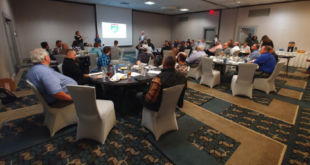
AHJ Perspective: Living in Glass Houses
They say that people who live in glass houses should never get involved in a rock throwing contest. On the other hand, if you do live in a glass house, you should take certain precautions like removing all the loose rubble from the outside so that malcontents cannot do damage.
Let’s talk for a moment about one of our glass houses – our fire stations. We don’t call them fire stations because we expect them to burn. The very term fire station should result in the building never being involved in a fire. But the harsh reality is that only a very small percentage of fire stations are adequately protected against fire by having a fire sprinkler system installed.
I have never seen an inventory of fire stations that are on record as being currently occupied. But, I have seen a research document that points out a definite weakness. According to the U.S. Fire Administration Topical Fire Research Series we experience as many as 150 fire station fires every year. This report provides many clues as to how we could strengthen protection of fire stations from unwanted fire. Some of its basic findings are:
- Fire station fires most often originate in fire station vehicles.
- The leading cause is electrical distribution, while cooking is the leading cause of structural fires.
- Electrical wire is the leading material ignited, most often short circuited.
- Often fire stations have no damage insurance or are underinsured.2
If we look at the fire station fire as a possibility, 150 fires is not that many when held up against the loss in residential fires, but it does represent a traumatic experience to any community that has to rebuild a firehouse. This begs the question: what is the shelf life of a firehouse? If we assume that there are about 33,000 fire departments in the United States, and if we agree that we burn down approximately 150 each year, it is easy to see that in 50 years a total of 7,500 opportunities for fire protection to be negatively impacted by fire station fires.
One of the solutions that we should be bringing to bear on this issue is sprinkler technology. All fire stations should be adequately sprinklered during initial construction. Secondarily, fire stations that are rebuilt as a result of having a fire should always be retrofitted with fire sprinklers. It is not uncommon for political figures to question why we would sprinkler a fire station. These people often think it is humorous that a fire station needs to be protected against fire. Facts say otherwise. It is not uncommon for a fire station to be victimized by an accidental fire. Sometimes a fire station is burned to the ground with a fire truck still in it. This makes this a serious public policy discussion.
The way to address this problem is to consider the question of: what will you do if you lose your firehouse? If you are a community with only one fire station, the consequences are severe. If you are a volunteer fire department that has limited financial resources, consequences are severe also.
In reality, this is also a public credibility issue. Many fire departments have expanded their support for built-in fire protection. When we advocate for residential sprinklers it is altogether appropriate that we put our own money where our mouth is. One of the ways of making sure that we are consistent with public policy is to put our efforts into sprinkling fire stations as examples of good public policy.
Beginning with a community’s master plan or strategic plan, the idea can be advocated as part of the planning process. By sprinkling all firehouses, the community sets an excellent example as a matter of public policy. In any case, considering the possibility of sprinklers in all new buildings should be strongly advocated by the fire marshal and supported by the fire chief. In replacement of existing facilities, sprinklers should be a top priority. Frequently, a question of retrofit may be raised if you intend to extend a shelf life of a fire station. We need to remember that fire stations are in many ways a second home for our firefighters. If we are suggesting that residences need to be protected, then it is logical that fire stations need to be also.
In almost all cases, there needs to be an advocate whether this is the fire chief or fire marshal is a matter of local choice. Without an advocate, the fire stations will remain a potential vulnerability to fire.
Summary
Remember that sprinklering fire stations means never having to say “I’m sorry” to the community.
REFERENCES:
1. Fire Station Fires, U.S. Fire Administration Topical Fire Research Series, Volume 1, Issue 19, May 2001 (Revised December 2001)
2. ibid
 ABOUT THE AUTHOR: Ronny J. Coleman is currently the president of Fireforceone. He is a past president of the IAFC and CFAI. Over his lifetime, he has received numerous awards including the AFSA’s 1989 Henry S. Parmelee Award, the 2011 Mason Lankford Award from the Congressional Fire Services Institute, and the Tom Brennan Lifetime Achievement Award from Fire Engineering in 2014. He continues as a contributor to the fire service in many ways.
ABOUT THE AUTHOR: Ronny J. Coleman is currently the president of Fireforceone. He is a past president of the IAFC and CFAI. Over his lifetime, he has received numerous awards including the AFSA’s 1989 Henry S. Parmelee Award, the 2011 Mason Lankford Award from the Congressional Fire Services Institute, and the Tom Brennan Lifetime Achievement Award from Fire Engineering in 2014. He continues as a contributor to the fire service in many ways.

 Sprinkler Age A Publication of the American Fire Sprinkler Association
Sprinkler Age A Publication of the American Fire Sprinkler Association
